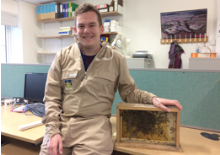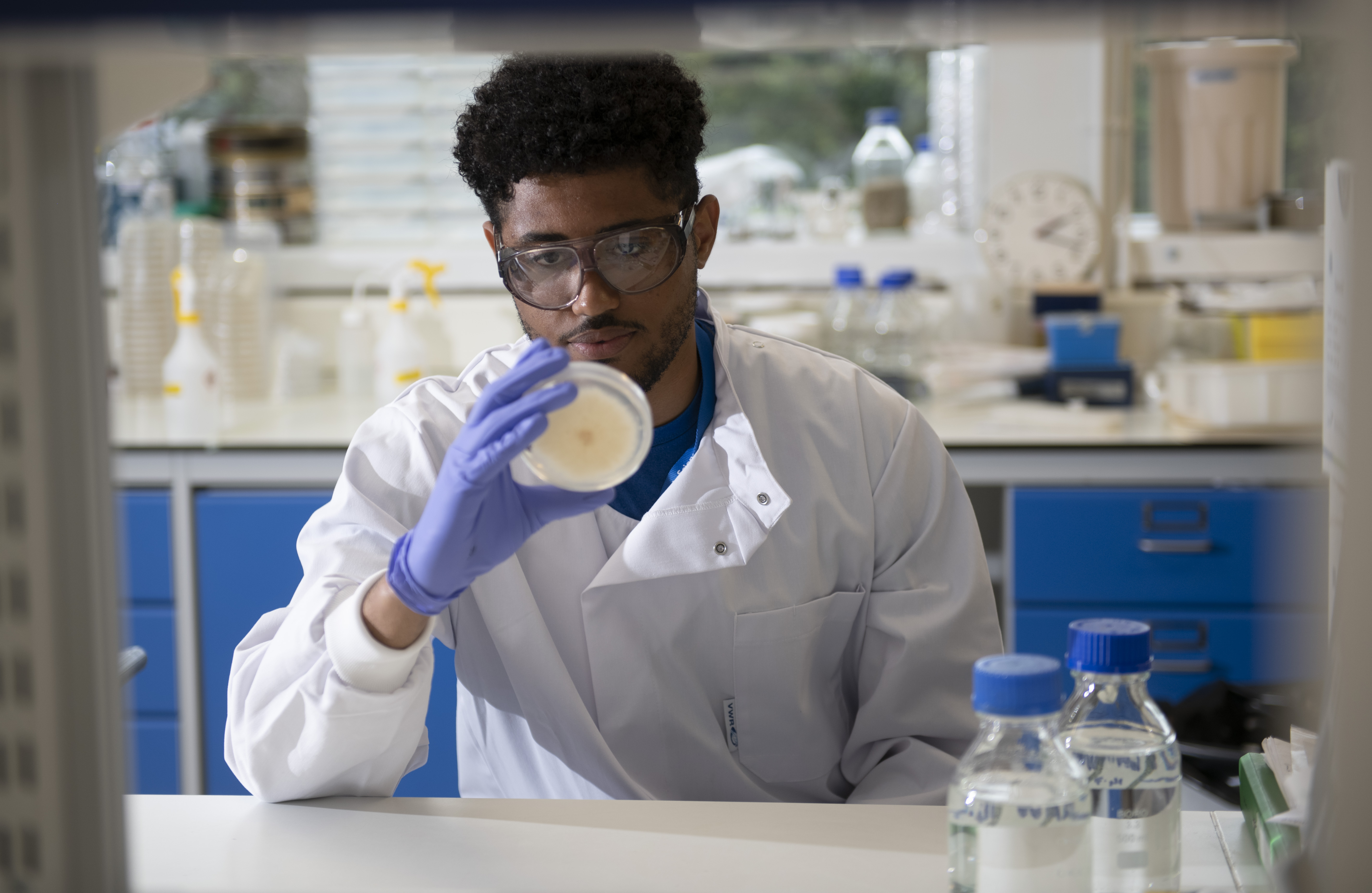Current PhD Student Projects based at Wellesbourne
Scott Dwyer
Project Title: Biologically-based control of Varroa destructor
Funder: Elizabeth Creak Charitable Trust & University of Warwick

The ectoparasitic mite, Varroa destructor and the viral diseases that it transmits, are a key cause of European honeybee, Apis mellifera (EHB), overwintering colony losses. Varroa has developed resistance to many synthetic pesticides. Few remain that do not kill bees and current alternative measures are only partially effective. There is an urgent need for new control methods underpinned by fundamental knowledge to ensure their sustainable use.
Previous research shows Varroa are susceptible to lethal infections by entomopathogenic fungi (EPF), which have potential to be used as biocontrol agents. A number of EPF species are available commercially for arthropod pest control. EPF are considered to be low risk to people, and we have identified strains of fungi that infect varroa but do not kill EHB. However, there are knowledge gaps about how EPF interact with varroa and bees and this is an impediment to commercialisation and use.
This project focuses upon characterising virulence of strains and species of EPF against Varroa and bees through laboratory bioassays. As well as understanding the effects of temperature upon the activity of EPF as within the hive EHB maintain relatively warm temperatures which can inhibit fungal activity. And finally, investigating the effects of fungal treatment on transmission and activation of bee viruses through quantitative PCR and if fungal treatment has immune priming effects on immune pathways associated with antiviral responses.
Becca McGowan
Project Title: The Biology and Integrated Management of the Bean Seed Fly
Funder: University of Warwick, Processors and Growers Research Organisation (PGRO) and Agriculture and Horticulture Development Board (AHDB)

Project summary:
The Bean Seed Fly (Delia platura and Delia florilega) causes damage to more than 40 crop species. In the UK, most damage is reported in peas, beans and onions. The larvae of the Bean Seed Fly burrow into the seeds and stems of seedlings causing ‘baldheadedness’ (lack of development from the cotyledons) in beans, yield reductions and plant death.
There is growing pressure to reduce insecticide use in horticulture. Insects are evolving resistance to insecticides and globally, pesticide use in agriculture is a major driver of biodiversity decline. The Bean Seed Fly has evolved resistance to insecticides and currently, there are no effective insecticides available to growers to aid in managing this pest in the UK. Growers require an alternative strategy to the sole use of insecticides to reduce damage caused by the Bean Seed Fly.
Growers are encouraged to use more sustainable strategies to manage pests rather than solely using chemical insecticides. Integrated Pest Management (IPM) is a collection of principles designed to enable the growth of healthy crops whilst minimising damage to agro-ecosystems. This is achieved by preventing pest species from establishing in a crop, monitoring pest populations and prioritising non-chemical plant protection products. The aim of this project is to contribute towards an IPM strategy to reduce crop and economic losses caused by the Bean Seed Fly.
The project has four objectives:
1. Investigate the overwintering strategy of the Bean Seed Fly: The Bean Seed Fly will have evolved adaptions to enable it to survive through the unfavourable conditions that occur during Winter. For example, does the Bean Seed Fly enter diapause (state of dormancy) over Autumn and Winter? The activity of the Bean Seed Fly can be predicted once more is known about the overwintering strategy of the Bean Seed Fly.
2. Create and validate a forecasting model to predict the Spring emergence of the Bean Seed Fly: The Bean Seed Fly emerges in large numbers in Spring when crops are being sown. Growers may be able to avoid planting during the time when the Bean Seed Fly are emerging if the dates of the Spring emergence of the Bean Seed Fly can be predicted.
3. Identify effective trapping methods to monitor the Bean Seed Fly: There are multiple species that look similar in traps to the Bean Seed Fly. Growers need to be confident that the traps that they use to monitor Bean Seed Fly are catching Bean Seed Fly opposed to similar species.
4. Assess and compare cultural and physical strategies to prevent damage from the Bean Seed Fly: Experiments are investigating if the timing of cultivation and covering of the crop with a fine mesh in relation to the sowing date will affect damage caused by the Bean Seed Fly.
Andrew Legg
Project Title: Exploiting pathogenomics and resistance for the control of Fusarium wilt of lettuce
Funder: BBSRC MITBP-CASE and Agriculture and Horticulture Development Board (AHDB)

Fusarium wilt of lettuce which is caused by the soilborne fungus Fusarium oxysporum f.sp lactucae (FOL) is responsible for huge economic losses worldwide in both protected and field grown lettuce. Four races of FOL have been identified so far, with race 1 (FOL1) being the most prominent globally and race 2 and 3 confined to Asia. FOL race 4 (FOL4) is newly emerged in Europe and has been reported in Belgium, France, Italy, and the UK where up to 70% yield losses can occur. A lack of plant resistance to FOL4 is therefore a major threat to commercial production of lettuce.
The main aims of this project are to examine new sources of resistance to FOL4, as well as study interactions with FOL1 and FOL4 isolates. So far, a collection of FOL1 and FOL isolates from different European locations has been assembled where a potentially important virulence gene (SIX8) with variable sequence was found in FOL4 isolates but was absent in FOL1. Furthermore, an in vitro lettuce seedling inoculation system has been developed for an RNAseq experiment to examine FOL4 gene expression when inoculated onto susceptible and resistant lettuce cultivars. Further functional studies using gene knockouts will then establish the role of different putative virulence genes In FOL4. Furthermore, resistance to both FOL1 and FOL4 has been identified within a lettuce diversity set as well as differentials, and selected lines are now being used by our project collaborator Enza Zaden to produce mapping populations with the aim of discerning the genetic nature of the resistance.
Sam Baillie
Project Title: Evidence-based Companion Planting for the Protection of Garden Plants
Funder: The Royal Horticultural Society & The University of Warwick (Warwick Industrial Fellowship)

Companion planting is often described as the creation of mutualistic plant communities where the species involved benefit from their interactions. Combining companion plants with cultivated edibles has been recommended as a viable pest control strategy, consequently allowing the reduction of pesticide applications. This approach is widely researched and has been implemented in commercial horticulture; for example, alyssum (Lobularia maritima) intercropped with lettuce, has shown to reduce aphid infestations. Furthermore, there is the potential for intercropping in arable farming systems. However, it is suggested that companion planting may be more appropriate and effective for the small-scale home gardens. Many combinations of companion plants are recommended by gardeners, seed companies and a wealth of popular garden literature, yet there is insufficient scientific evidence relating to the efficacy of these claims.
Working with horticulturalists and entomologists from the RHS (Royal Horticultural Society), this project aims is to test the efficacy of popular companion and cultivated edible plant pairings through field trials at RHS garden Wisley and the Wellesbourne Crop Centre. Complementary no-choice experiments, dual-choice bioassays, and field trials will aim to elucidate the biological mechanisms through which pest behaviour is modified by the companion planting (e.g., volatile chemicals and visual cues influencing host plant finding and colonisation, or through the attraction of beneficial natural enemies). The aim of the project is to recommend combinations of cultivated edibles and companion plants to gardeners through the RHS, providing effective companion planting options supported by scientific evidence.
Fiona Tainsh
Project Title: TBC
Funder: BBSRC MIBTP

The cultivation of commercial horticultural edible crops is reliant on insect pollinators to produce fruits and seed, most of which is done by bees, including wild bees (solitary species, as well as social bumblebees) and managed bees, primarily honeybees (Apis mellifera) and bumblebees. Increasing pressures on production – associated with increased demand for fresh produce from consumers, concerns about food security, and the challenges of climate change – mean that growers are having to pay more attention to pollination.
This project concerns the red mason bee (RMB), Osmia bicornis, which is important as a wild pollinator of horticultural crops and is used on a commercial basis throughout Europe. For commercial use, cocoons are placed in the crop in the spring, alongside a series of nest tubes spaced throughout the crop in which the bees can make cells. The tubes are collected back in the summer and cocoons are extracted in the autumn and overwintered. The system allows larger populations of mason bees to be maintained in the crop than would otherwise be the case with no intervention, and this translates into better crop pollination.
Relatively little is known about red mason bee basic biology and therefore keeping large, dense populations in the field has the potential to negatively impact wild bees, with the risk that an unknown infectious disease could spread through a dense commercial population and into wild bees. This project will therefore identify RMB immune associated genes as well as using traditional pathology to identify common diseases and their symptoms. There is also a lack of information regarding RMB population genetics, including the structure of metapopulations and levels of gene flow between them. To better understand the relatedness of different populations of RMB, we will monitor how artificially added red mason bee populations spread within an orchard where the species was not previously present as well as identifying microsatellites within the RMB genome to compare the relatedness of different populations across the UK.
Rebecca Sanders
Project Title: A holistic approach to Integrated Pest Management: investigating a new strategy for aphid management combining durable host plant resistance with fungal bioprotectants
Funder: BBSRC MIBTP

The management of insect pests of horticultural crops over the last century has become deeply reliant on blanket insecticide applications. These pesticides cause widespread ecological damage to non-target species and exert a heavy selection pressure that’s led to the emergence of resistance in the target-species. In recent years many of these treatments have been withdrawn from the market in the EU, forcing growers to seek alternative pest management strategies.
This work explores the use of a combination of partial host-plant resistance to the aphid pest Myzus persicae in brassica oleracea with foliar spray applications of entomopathogenic fungi (EPF) as a biopesticide. Previous research demonstrated evidence of an interaction between partial resistance and EPF, and thus their suitability for combination as part of an integrated pest management strategy. It is hypothesised that this effect relates to differential synthesis of jasmonic acid(JA) and salycilic acid (SA) between partially-resistant and susceptible lines.
This project aims to:
- Explore the relationship between EPF infection and aphid nymph moulting by precise quantification of larval instar development time on differentially resistant brassica lines, using a semi-automated bioassay system which will gather higher resolution data than conventional life-stage studies and lend itself to scale-up
- Quantify expression of genes associated with JA and SA signalling pathways in these brassica lines, in the presence of aphid feeding +/- EPF infection using qRT-PCR. Conduct similar qRT-PCR to look at concurrent Toll expression in the aphids.
- Conduct aphid population bioassays in the different brassica lines using selected EPF strains . The data from these bioassays will be fed into a boxcar model. Different EPF application scenarios will be modelled in silico and then tested in the bioassay system.
Emily Turner
Project Title: Integrated control of Fusarium wilt of lettuce in relation to pathogen and microbial community dynamics
Funder: BBSRC CTP for Sustainable Agricultural Innovation and G's Fresh

Fusarium oxysporum is responsible for wilt disease of many species of commercial crops worldwide, it is a soilborne, ascomycete, filamentous fungus that colonises and penetrates the root systems of host plants. Fusarium wilt disease of lettuce, caused by Fusarium oxysporum f.sp. lactucae (FOL), is a major constraint to production of protected and field-grown crops globally.
Disease resistant lettuce cultivars have been bred to reduce losses due to FOL but new pathogen races have evolved to overcome this resistance. Currently, there are four FOL races; FOL1 is the most widespread (particularly in southern Europe and the USA) whilst FOL2 and 3 are confined to Asia. More recently FOL4 has emerged which has particularly affected protected lettuce in Northern Europe including the UK.
These areas are experiencing increased prevalence of Fusarium wilt with higher temperatures favouring increased disease development and losses of 50-80% are common, this threat will be further exacerbated by climate change. Lettuce breeding companies are beginning to address these challenges by identifying sources of resistance to both FOL1 and FOL4 but other approaches for control and management of FOL as well as an understanding of its biology and dynamics are urgently required to enable a swift response to new outbreaks in a changing climate.
The main aim of my PhD is to develop sustainable integrated disease management approaches for both FOL1 and FOL4 in lettuce with a focus on field production in Spain.
The project will involve identification and characterisation of FOL isolates from Spain, evaluation of solarisation, biological control and the use of disease resistant / tolerant lettuce varieties for control as well as development and implementation of different approaches to microbial community analyses with a focus on monitoring of FOL and beneficial microbes. The project is a collaboration between Gs Growers, the University of Warwick and NIAB Cambridge.
